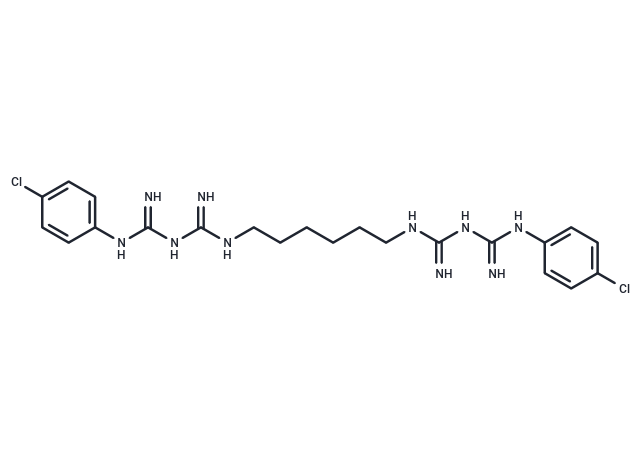Shopping Cart
- Remove All
 Your shopping cart is currently empty
Your shopping cart is currently empty
Chlorhexidine (Rotersept) is a biguanide compound used as an antiseptic agent with topical antibacterial activity. Chlorhexidine is positively charged and reacts with the negatively charged microbial cell surface, thereby destroying the integrity of the cell membrane. Subsequently, chlorhexidine penetrates into the cell and causes leakage of intracellular components leading to cell death. Since gram-positive bacteria are more negatively charged, they are more sensitive to this agent.

| Pack Size | Price | Availability | Quantity |
|---|---|---|---|
| 500 mg | $40 | In Stock | |
| 1 g | $56 | In Stock | |
| 5 g | $133 | In Stock | |
| 10 g | $198 | In Stock | |
| 1 mL x 10 mM (in DMSO) | $50 | In Stock |
| Description | Chlorhexidine (Rotersept) is a biguanide compound used as an antiseptic agent with topical antibacterial activity. Chlorhexidine is positively charged and reacts with the negatively charged microbial cell surface, thereby destroying the integrity of the cell membrane. Subsequently, chlorhexidine penetrates into the cell and causes leakage of intracellular components leading to cell death. Since gram-positive bacteria are more negatively charged, they are more sensitive to this agent. |
| Synonyms | Rotersept, Nolvasan, Chlorhexidinum |
| Molecular Weight | 505.45 |
| Formula | C22H30Cl2N10 |
| Cas No. | 55-56-1 |
| Smiles | Clc1ccc(NC(=N)NC(=N)NCCCCCCNC(=N)NC(=N)Nc2ccc(Cl)cc2)cc1 |
| Relative Density. | 1.39 g/cm3 |
| Storage | Powder: -20°C for 3 years | In solvent: -80°C for 1 year | Shipping with blue ice/Shipping at ambient temperature. | |||||||||||||||||||||||||
| Solubility Information | DMSO: 15 mg/mL (29.68 mM), Sonication is recommended. | |||||||||||||||||||||||||
Solution Preparation Table | ||||||||||||||||||||||||||
DMSO
| ||||||||||||||||||||||||||

Copyright © 2015-2025 TargetMol Chemicals Inc. All Rights Reserved.